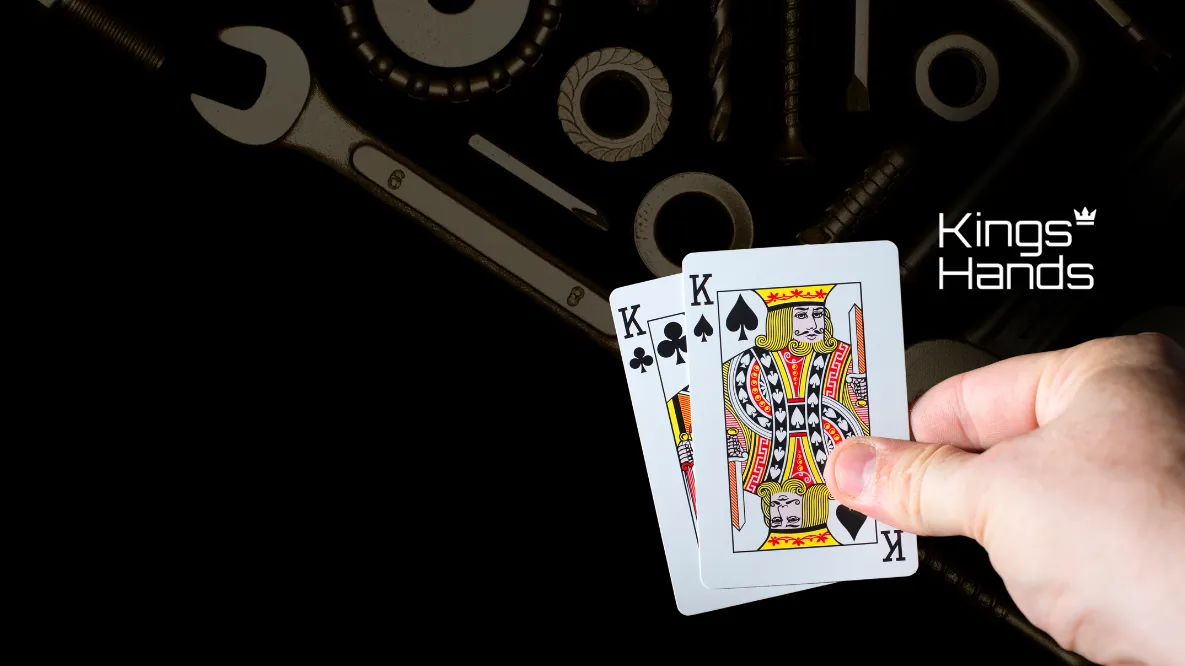Every single decision you make at the poker tables boils down to risk and reward. It might not always seem that way, especially if you’re clicking buttons, but the fundamentals behind every choice do come down to this. How much do we stand to lose by making this play, and how much do we stand to gain? How often do we think each outcome will occur?
There is a very simple bit of mathematics which is key to answering these common questions in game, which can be used either in calling spots or raising spots, especially with regard to bluffing opportunities.
Alongside a basic understanding of poker odds and outcomes, and a good ability to put your opponents on an appropriate range, this is really all you will need in the way of maths to start understanding and beating the game, and we’ll run over the details below.
The Maths – Calling a Bet on the River
Whenever you are committing chips into a pot in poker, there’s some basic mathematics attending your actions. Let’s give a simple example.
You get to the river heads-up and the pot is $10. Your opponent is first to act and bets $10 into the $10 pot, making it $20 in the middle. You have to choose between calling $10, folding and of course raising.
Let’s assume that in this case we think our opponent is either bluffing or has a big hand, and that we have a mid-strength value hand.
The question remains: should we call or fold? Let’s look first at the odds we are being laid by our opponent. When we call and lose, we are losing $10, that’s the amount we are risking. When we call and win, we are winning $20, the potential reward. Therefore we are getting direct odds of 2 : 1 on the call.
How often do we need to be correct to break even on our call? It is quite simple to turn any ratio into a percentage, we simply divide the amount on the right-hand side (1) by the total of both sides in the ratio (2+1), so the answer is (1 / (2 + 1)) = ⅓ or 33.33%. If we win more often than this, we are making profit and our call is +EV (positive in equity value).
We can see intuitively that this makes sense, since if we were to play this situation out thousands of times, and we lose $10 two thirds of the time and win $20 one third of the time, overall we will break even and neither lose nor win money. This is known as our break-even point.
If we believe, therefore, that our opponent is bluffing more often than a third of the time, we can comfortably make the call in this spot. Even if we lose the pot 60% of the time, we will still be making profit in the long run, if we played this spot out numerous times.
For clarity, let’s consider a couple of different sizings. How often do we need our opponent to be bluffing for us to make profit on our bluff-catcher call if he’s bluffing with a half-pot sizing of $5? In this case we are calling $5 to win $15, and the direct odds are 3 : 1. The equation becomes 1 / (3 + 1) = ¼ or 25%. Now we only need to be correct 25% of the time in order to break even on the call, so if we think he is bluffing more often than ¼ of the time, we can make the call.
Bear in mind that as villains bet smaller, it is often less likely that they are bluffing, especially in the lower stakes. To some extent you must trust your instincts, and when a bet smells like a value play, it often is!
If our opponent on the other hand over-pots it and bets $20 into the $10 pot, we will need to call $20 to potentially win $30, so the direct odds become 2 : 3. Now we must calculate our break-even point using the following maths: 2 / (3 + 2) = ⅖ or 40%. Now we must be confident our opponent is bluffing with a higher frequency in order for us to make the call.
The Maths – Betting as a Bluff on the River
Let’s look at the same scenario in reverse, and imagine we are the villain who was betting full pot on this river. Let’s further imagine that we have nothing, and we are simply bluffing to try to take down the pot. How often does a $10 bluff into a $10 pot need to work in order to break even?
Once again the maths is very simple. In this spot we are risking $10 for the chance to win $10. There’s no way to win any more than this, since we are bluffing and when called we will lose the pot. The direct odds are 1 : 1. In this case the maths needed to get a break-even percentage are even simpler, it is simply 1 / (1 + 1) = ½ or 50%. If the bluff works half the time, we will break even on our play in the long run.
Let’s consider the bluff using different sizings. If we bluff half-pot, this would be $5 into a pot of $10. Now we only need the bluff to work with the following frequency to at least break even: 1 / (2 + 1) = ⅓ or 33.33%. Since we are risking less, the bluff needs to work less often to break even or to turn a profit. Bearing in mind of course smaller bluffs are generally prone to work less often.
If we bluff an over-pot sizing, say $20 into the $10 pot, now we must use different inputs. We are risking twice as much as we stand to gain if the bluff works. Now the maths equates to 2 / (1 + 2) = ⅔ or 66.66%, so we need the bluff to work two thirds of the time just to break even.
Whether we are considering a call vs. a polarized range (either bluffing or a very strong hand) or a bluff versus an opponent, the basic maths is the same, since it boils down to risk evaluated against reward. How much are we risking, how much is the reward, and how often do we think we will win or lose in the spot?
These are the fundamental questions, and the basic maths behind them is always the same: risk divided by (risk + reward) = our break-even point.
Why on the River?
We have used the examples above, situated on the river, for one very simple reason – no cards are left to come out on the board. This means that it is the final round of betting, and when we call or fold to that final bet, the hand is concluded. This means that we need only think about direct odds, the ratio we have given above which indicates the ratio between risk and reward.
Look out for more PokerDeals Strategy Content coming soon, as we open our strategy section on PokerDeals.com! You can also join us on Discord with this awesome invite link. See you there!





















